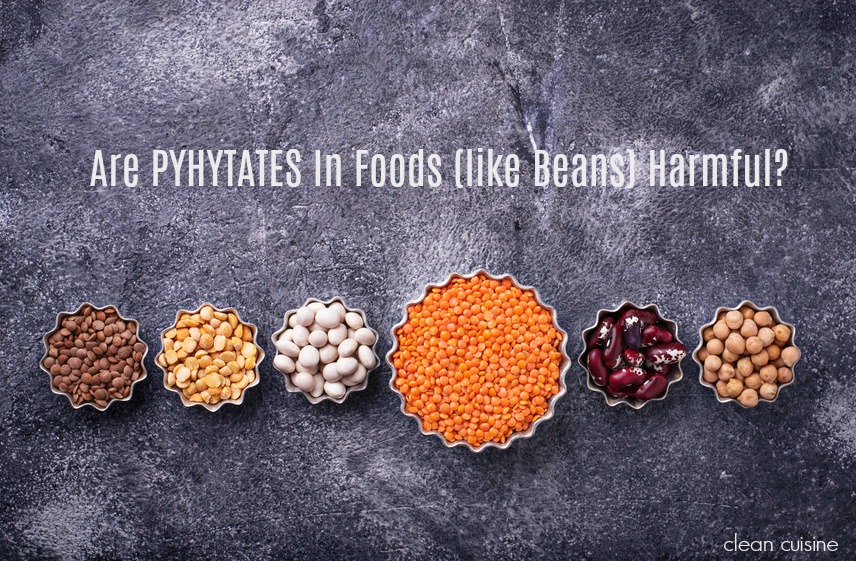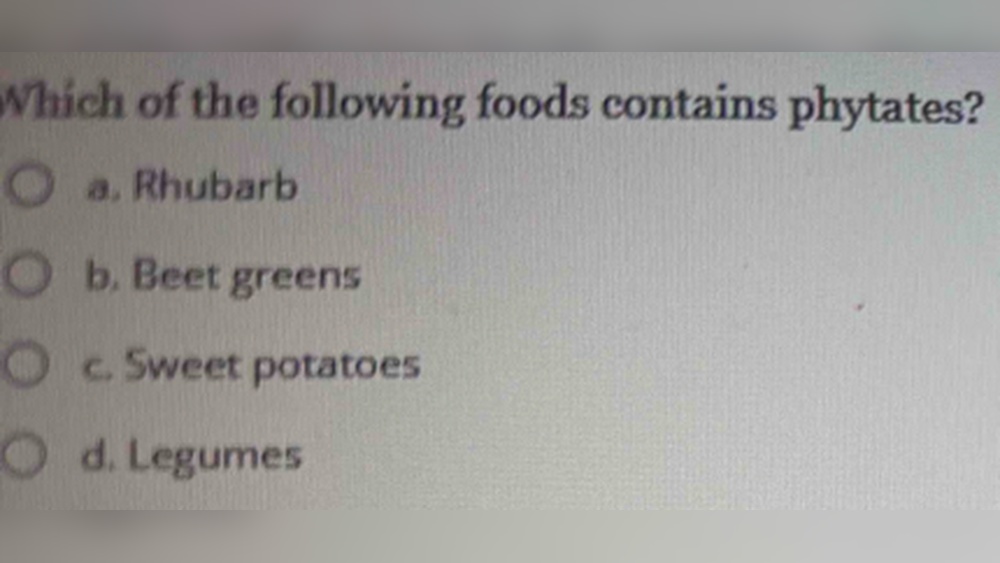Are you curious about which common foods contain phytates and how they might affect your nutrition? Understanding phytates is key because these natural compounds are found in many everyday foods you might eat without a second thought.
But do you know which foods pack the highest levels? If you want to learn how phytates can influence your body’s mineral absorption and discover simple tips to manage their impact, keep reading. This article will guide you through the foods rich in phytates—especially legumes—and explain why knowing this can make a difference to your health and diet choices.

Credit: www.chegg.com
Phytates In Plant Foods
Phytates are natural compounds found mainly in plant foods. They store phosphorus in seeds, grains, nuts, and legumes. Phytates affect mineral absorption but also have health benefits.
Understanding which plant foods contain phytates helps balance diet and nutrition. These compounds appear in many common foods people eat daily.
Grains And Phytates
Whole grains like wheat, oats, and brown rice contain phytates. The bran layer holds the highest amount. Refined grains have fewer phytates because the bran is removed.
Legumes And Phytates
Beans, lentils, and peas are rich in phytates. Soybeans and soy products such as tofu also contain these compounds. Legumes provide protein and fiber along with phytates.
Nuts And Seeds With Phytates
Many nuts like almonds, walnuts, and cashews carry phytates. Seeds such as sesame, sunflower, and flaxseeds have them too. These foods offer healthy fats and minerals.
Vegetables Containing Phytates
Some vegetables like potatoes, carrots, and beets hold smaller amounts of phytates. Leafy greens such as spinach also contain these compounds. Their phytate content is lower than grains or legumes.
Grains With High Phytate Levels
Grains are a major source of phytates in many diets worldwide. Phytates naturally occur in the outer layers of grains. These compounds can bind minerals, which may reduce their absorption in the body. Understanding which grains have high phytate levels helps manage nutrient intake effectively.
Whole Wheat And Oats
Whole wheat contains high phytate levels, especially in the bran. The bran is the outer layer where most phytates concentrate. Oats also have significant phytate content in their hulls and outer layers. Eating whole wheat and oats provides fiber and nutrients but also more phytates compared to refined grains.
Rice Bran Content
Rice bran, the outer coating of rice grains, is rich in phytates. Brown rice has more phytates than white rice because it retains the bran. Rice bran is often used as a supplement or ingredient but carries high phytate levels. Removing bran lowers phytate content but also reduces some nutrients.
Legumes As Major Sources
Legumes rank among the top foods containing phytates. These natural compounds store phosphorus in plant seeds. Phytates are especially high in many types of legumes. Eating legumes provides fiber, protein, and important minerals despite their phytate content.
Phytates can bind minerals like iron and zinc, affecting absorption. Yet, legumes remain a nutritious part of many diets worldwide. Understanding which legumes have phytates helps balance diet choices.
Common Beans And Lentils
Common beans such as kidney, black, and pinto beans contain significant phytate levels. Lentils, often used in soups and stews, also have high phytates. These legumes store phytates mainly in their seed coats. Soaking and cooking reduce phytate content and improve mineral absorption. Regular consumption of beans and lentils offers protein and fiber benefits despite phytates.
Soy And Soy-based Products
Soybeans contain one of the highest phytate levels among legumes. Soy products like tofu, tempeh, and soy milk also carry these compounds. Processing soy can lower phytate content but does not eliminate it entirely. Soy remains a valuable protein source with health benefits beyond phytates. Including soy in the diet supports muscle and bone health.
:max_bytes(150000):strip_icc()/phytic-acid-5088824-Final-3ca046a629d34278b259342af7b5c234.jpg)
Credit: www.verywellhealth.com
Nuts And Seeds Containing Phytates
Nuts and seeds are common foods containing phytates. These natural compounds store phosphorus in plants. Phytates can bind minerals, affecting their absorption in the body.
Many nuts and seeds have notable phytate content. They offer nutrients but also have this anti-nutrient. Understanding which nuts and seeds contain phytates helps in balancing diet choices.
Almonds
Almonds contain a moderate amount of phytates. They are a popular snack and ingredient in many dishes. Their phytate content can reduce mineral absorption slightly. Soaking or roasting almonds may lower phytate levels.
Walnuts
Walnuts also hold phytates, though less than almonds. They provide healthy fats and antioxidants. Walnuts’ phytate content is part of their natural defense mechanism. This compound may reduce the availability of some minerals.
Cashews
Cashews have a high level of phytates compared to other nuts. Their creamy texture makes them a favorite in cooking. Phytates in cashews can bind iron and zinc, reducing absorption. Light roasting can decrease phytate concentration.
Sesame, Sunflower, And Flaxseeds
Seeds like sesame, sunflower, and flax contain significant phytates. These seeds are rich in fiber, healthy fats, and minerals. Phytates may limit mineral uptake but offer antioxidant benefits. Preparing seeds by soaking or grinding can help reduce phytate effects.
Vegetables With Phytate Content
Phytates are natural compounds found in many plant-based foods. Vegetables also contain phytates, but usually in smaller amounts than grains or legumes. Knowing which vegetables have phytates helps balance nutrient intake and absorption.
Some root vegetables and leafy greens contain notable levels of phytates. These foods contribute to your daily phytate consumption and have health benefits as well.
Root Vegetables And Tubers
Root vegetables like potatoes and sweet potatoes have phytate content. Carrots, turnips, and beets also contain some phytates. These phytates mainly reside in the outer skin or peel of these vegetables. Cooking and peeling can reduce their phytate levels. Despite phytates, these vegetables provide important vitamins and minerals.
Leafy Greens Like Spinach
Spinach is a leafy green rich in phytates. Beet greens and Swiss chard contain phytates as well. Phytates in leafy greens can slightly reduce mineral absorption. Eating a variety of vegetables ensures you get enough nutrients without excess phytates. Spinach remains a healthy choice due to its vitamins and antioxidants.
Phytates And Mineral Absorption
Phytates are natural compounds found in many plant-based foods. They bind to minerals like iron, zinc, and calcium. This binding can lower the amount of minerals the body absorbs. As a result, phytates may reduce mineral availability from the diet.
Understanding how phytates affect mineral absorption helps in planning balanced meals. It is important for people who rely on plant foods for their nutrients. Some foods contain higher levels of phytates and need special preparation to reduce their effects.
What Are Phytates?
Phytates, also called phytic acid, store phosphorus in plants. They are mainly found in seeds, nuts, legumes, and whole grains. Phytates protect plants but can affect human nutrition by binding minerals. This action forms compounds that the body cannot easily digest.
How Phytates Affect Mineral Absorption
When phytates bind to minerals, they create insoluble complexes. These complexes pass through the digestive system without releasing minerals. This lowers the amount of iron, zinc, and calcium absorbed. People with mineral deficiencies may need to watch phytate intake.
Foods High In Phytates
Legumes, such as beans, lentils, and peas, contain high phytate levels. Whole grains like wheat, oats, and brown rice also have many phytates. Nuts including almonds and walnuts, and seeds like sesame and flaxseed, are rich in phytates. Some vegetables like spinach and potatoes contain smaller amounts.
Reducing Phytates To Improve Mineral Absorption
Soaking, fermenting, or sprouting grains and legumes lowers phytate content. Cooking can reduce phytates but is less effective than soaking or fermentation. Combining phytate-rich foods with vitamin C can improve mineral absorption. Balanced diets with varied foods help maintain good mineral levels.
Health Benefits Of Phytates
Phytates, found in many plant-based foods, offer several health benefits. These natural compounds act beyond their role as nutrient storage in seeds and grains. They contribute to protecting cells and supporting overall well-being. Understanding the positive effects of phytates can help appreciate their place in a balanced diet.
Antioxidant Properties
Phytates have strong antioxidant abilities. They help neutralize harmful free radicals in the body. This action reduces oxidative stress, which can damage cells. By lowering oxidative damage, phytates support healthy aging and cell function. Eating foods rich in phytates can boost your body’s defense system naturally.
Chronic Disease Protection
Research shows phytates may help protect against chronic diseases. They can reduce the risk of heart disease by improving blood vessel health. Phytates also play a role in lowering blood sugar levels and supporting bone health. Their presence in legumes, nuts, and whole grains links to lower rates of diabetes and certain cancers. Including phytate-rich foods supports long-term health and disease prevention.
Reducing Phytate Levels In Foods
Phytates naturally occur in many plant-based foods. They can bind minerals like iron, zinc, and calcium. This binding may lower mineral absorption in the body. Reducing phytate levels in food helps improve nutrient availability. Several simple methods work well to reduce these compounds. These techniques make grains, legumes, nuts, and seeds healthier to eat.
Soaking And Cooking Techniques
Soaking grains, beans, or nuts in water softens them. This process activates enzymes that break down phytates. Use warm water and soak for several hours or overnight. Rinse well after soaking to remove released phytates.
Cooking also helps reduce phytate content. Boiling or pressure cooking degrades phytates effectively. Combine soaking and cooking for best results. This approach lowers phytate levels significantly in legumes and whole grains.
Surprising Foods With Phytates
Phytates are natural compounds found in many plant-based foods. They can affect mineral absorption but also have antioxidant benefits. Some foods contain more phytates than people expect. Recognizing these surprising sources helps in planning a balanced diet.
Whole Grains
Whole grains like wheat, oats, and brown rice contain phytates. The bran layer has the highest amount. Refined grains have fewer phytates because processing removes the bran.
Legumes
Beans such as kidney, black, and pinto beans are rich in phytates. Lentils and peas also have high levels. Soybeans and soy products like tofu contain phytates too.
Nuts And Seeds
Almonds, walnuts, and cashews hold significant phytates. Seeds such as sesame, sunflower, and flaxseeds also contain these compounds. They store phosphorus to support seed growth.
Certain Vegetables
Some vegetables have phytates but usually in smaller amounts. Potatoes, carrots, and beets are examples. Leafy greens like spinach also contain phytates.

Credit: cleancuisine.com
Frequently Asked Questions
Which Foods Contain Phytates?
Phytates occur mainly in legumes, whole grains, nuts, and seeds. Foods like beans, lentils, almonds, and oats contain them. Some vegetables, such as spinach and potatoes, have smaller amounts. Phytates store phosphorus and may affect mineral absorption.
Which Of The Following Foods Contains Phytates: A Rhubarb B Beet Greens C Sweet Potatoes D Legume?
Legumes contain phytates, which store phosphorus in plants. Rhubarb, beet greens, and sweet potatoes have lower phytate levels. Phytates can reduce mineral absorption but also offer antioxidant benefits. Soaking legumes before cooking decreases their phytate content.
What Is An Example Of A Phytate?
An example of a phytate is found in legumes, such as beans, lentils, and peas. Legumes contain high phytate levels.
Does Rice Contain Phytates?
Yes, rice contains phytates, mainly in the outer bran layer. These compounds may reduce mineral absorption but offer antioxidant benefits.
Conclusion
Phytates mainly appear in legumes, grains, nuts, and seeds. These foods hold natural compounds that can affect mineral absorption. Eating them in balanced amounts supports good nutrition. Processing methods like soaking or cooking reduce phytate levels. Remember, legumes provide important nutrients despite phytates.
Choose a variety of foods for a healthy diet. Understanding phytates helps make smarter food choices. Keep exploring different foods to maintain balanced nutrition.

